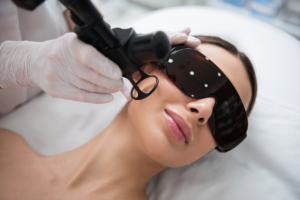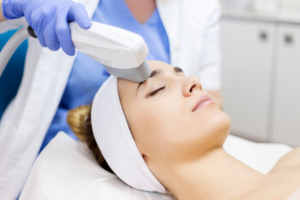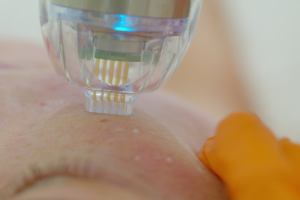
Laser skin resurfacing is proven to reduce wrinkles, age spots, acne scars, and other blemishes as well as tighten skin and balance tone. Yet, because of the variety of options, it can be difficult to know which type of resurfacing treatment may be right for you.
When should I receive a laser or skin resurfacing treatment?
Did you know that fall and winter are considered “the laser season”? This is primarily because laser-treated skin is hypersensitive to sun exposure [for up to a year following some procedures]. So, it is recommended to choose laser resurfacing during fall or winter months, when you are spending most of your time indoors. Regardless of what time of year you have your laser procedure, sunscreen is a must—wearing a broad-spectrum SPF 30 or higher daily. Sunscreen not only helps to keep your results looking their best, but it also provides protection against skin cancer and helps prevent additional premature aging.
What do laser or skin resurfacing treatments feel like?
Many commonly compare the sensation felt during a laser treatment to a rubber band snapping against the skin. However, what a laser resurfacing treatment feels like depends on the laser, the depth and area of treatment, and the individual’s tolerance for pain.
Erbium Laser 
Our Erbium Laser may be performed deeply ablative or lightly ablative. The deeper the ablative resurfacing laser treatment may require local anesthetic injections for comfortability during the procedure. The Erbium Laser Resurfacing Treatment promotes collagen remodeling, making them popular for treating fine lines, wrinkles, skin laxity, age spots, and more.
 Intense Pulsed Light (IPL)
Intense Pulsed Light (IPL)
A non-ablative treatment, technically not a laser, but often used to treat similar concerns as lasers, such as sun damage, vascular lesions, acne, rosacea, and hyperpigmentation. IPL uses light to treat skin pigmentation problems and rejuvenate the complexion—requiring little to no downtime.
RF Microneedling

Another non-ablative treatment is RF Microneedling. If you have loose facial skin, poor skin texture, and fine lines. Radiofrequency energy gently heats the outer layer of your skin, leaving the surrounding tissue undamaged. Combining microneedling with radiofrequency energy is one of the best ways to treat signs of aging and feel more comfortable in your skin. Several weeks after treatment, patients experience tighter skin. It is considered far more effective than over-the-counter solutions.
Although laser treatments are generally considered non-surgical, not all are downtime-free. Laser resurfacing recovery time varies depending on the type of laser used, as well as an individual’s health and healing rate.
Sometimes a single laser treatment will take care of a patient’s concerns; however, most non-ablative lasers call for a series of treatments to produce the most satisfying results. This is a trade-off that comes with a no-downtime treatment, but once the treatment series is complete, the results are long-lasting.
A common misconception is that laser resurfacing is only safe for light skin types. While it is true that certain lasers pose a higher risk for cell damage or discoloration in darker skin, there are safe and effective resurfacing options. For lighter-toned African American, Hispanic, or Asian skin tones, the Erbium Laser Resurfacing can sometimes be a good option, posing less risk for discoloration. Patients with darker brown or black skin may need to consider other skin resurfacing options, such as RF Microneedling.
Call us at 423.509.5630 to schedule your laser or skin resurfacing treatment today!
